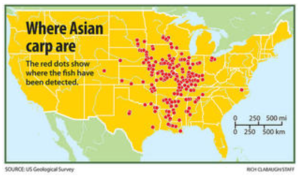Closeup on Carp: CO2 for Ecological Innovation
By Bianca Loglisci, C2ST Intern, Loyola University
You’re likely familiar with the frowned-upon chemical compound carbon dioxide, CO2– a dangerous greenhouse gas that when released into the atmosphere in large amounts can drastically escalate the effects of climate change. But did you know that CO2 can be helpful in certain conservation efforts? Scientists have recently discovered and started implementing a new method of controlling invasive carp species in freshwater ecosystems. In some cases, CO2 may not be so bad after all!

Carp originally come from Asia, so the umbrella term “Asian carp” is the umbrella term for four species: Bighead carp, black carp, grass carp, and silver carp. Asian carp were brought to the US because they love to eat small aquatic organisms, so they were a perfect mechanism for cleaning up algae, snails, and aquatic plants from the bottom of ponds used for raising catfish. At first, people thought the carp were unable to reproduce and therefore not a threat, but when they accidentally escaped into the Mississippi River, they started reproducing faster than anyone could have expected and haven’t stopped since. Because they are such hungry bottom feeders by design, Asian carp have been rapidly eating up food that native species (who are essential to existing ecosystems) need to survive. Fast reproduction rates combined with an impressive ability to eat have turned Asian carp into a classic invasive species story, but that doesn’t mean the problem is easy to solve.
Asian carp have become a huge problem in several areas of the US, especially in the Midwest, and the problem is growing faster than we can solve it; scientists have worked hard to develop new ways of driving out the fish, including infusing waters with CO2 gas. The process works very similarly to how soda water gets carbonated– recycled CO2 gas stored in giant metal cylinders gets injected into the water via tubes. When the carp swim in waters injected with CO2, they start to move much more slowly or irregularly, reducing their ability to eat and reproduce. Some carp will swim away to other areas of the water to avoid the gas.

This is a map of where Asian carp have been found in the US. Source
Scientists have observed that most other species of fish that would be affected in similar ways tend to avoid CO2 by swimming away before it reaches them. Additionally, sheets of ice on the water’s surface during the winter can create a natural barrier that prevents CO2 from leaving the water and entering the atmosphere. This can reduce any risk of greenhouse gas emissions that exacerbate climate change. Even though this may sound promising, the method isn’t foolproof. Further research is needed to understand CO2’s long-term effects on freshwater species since the technology is novel and has only been approved for use within the last few years. Thankfully, scientists are still hard at work learning more about the potential problems and benefits of using CO2 in this new, ecologically positive approach. So far, it has proven to be a promising way we might finally be able to solve the urgent Asian carp issue that has been threatening ecosystems across the US for decades.
Resources:
2. https://setac.onlinelibrary.wiley.com/doi/10.1002/etc.4855
3. https://pubs.usgs.gov/fs/2022/3012/fs20223012.pdf
5. https://www.invasivespeciesinfo.gov/aquatic/fish-and-other-vertebrates/invasive-carp
6. https://www.treehugger.com/invasive-species-asian-carp-5114466#toc-how-did-asian-carp-get-to-the-us
7. https://impactsofinvasivespecies.weebly.com/asian-carp.html
8. https://www.usgs.gov/news/national-news-release/invasive-asian-carp-respond-strongly-carbon-dioxide